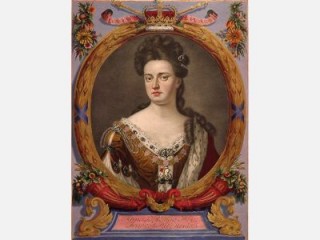
Queen Anne biography
Date of birth : 1665-02-06
Date of death : 1714-08-01
Birthplace : London, England
Nationality : British
Category : Historian personalities
Last modified : 2010-12-07
Credited as : Queen of England, daughter of James Duke of York, wife of John Churchill
Anne was queen of England from 1702 to 1714 and, after 1707, of Great Britain. During her reign England won a long war with France and persuaded Scotland to join in a new united kingdom of Great Britain. She was the last Stuart ruler.
On Feb. 6, 1665, Anne was born in London, the second daughter of James, Duke of York. Her father was a Roman Catholic, but her mother, Anne Hyde, was a Protestant, and Anne was brought up and remained a staunch Church of England Protestant. In 1677 her sister, Mary, to whom she was devoted, married William of Orange and moved to his country, Holland. Six years later Anne married Prince George of Denmark and established her own court in London. There the leading figure was Sarah Churchill, to whom Anne was greatly attached. Sarah was the wife of John Churchill, later 1st Duke of Marlborough, and she and her husband's family and friends dominated Anne's court.
Anne's father became king as James II in 1685. His reign was a difficult period for Anne, the more so when her Italian Catholic stepmother produced a male child who blocked the two Protestant princesses from the throne. Public dissatisfaction with James for his Catholicism and his excessive emphasis on royal power was already widespread. The birth of a Catholic heir crystallized discontent into revolution, and James was deposed in 1688. Anne's sister and her husband took the English throne as King William III and Queen Mary II.
With her sister back in England and Sarah Churchill and her friends close by, Anne was happier for a while. Then came Mary's death in 1694 and 4 years later a worse loss. Brought to childbed 15 times, Anne lost every child but one, the Duke of Gloucester, and in 1698 he died at the age of 9. This left no Protestant English heir to the throne and forced Parliament to provide for a German successor should both William and Anne die without surviving children, and this situation did, in fact, occur.
On March 8, 1702, Anne succeeded to the English throne. She was a semi-invalid, content—aside from concern for the Church of England and the appointment of individuals whom she favored—to leave major policy to the Duke of Marlborough and his friend Sidney Godolphin. They in turn entrusted the management of Parliament to Robert Harley, leader of the Tories. The War of the Spanish Succession against Louis XIV of France was the great issue, and on this Anne loyally backed Marlborough and Godolphin. She rejoiced with them in the victory of Blenheim (1704) and, to a lesser degree, in the union with Scotland (1707).
When the Tories proved less enthusiastic about the war than the Whigs, the government was forced to rely on the Whig party, with its support among Nonconformists and commercial interests. Relations became strained between the Queen and Lady Marlborough, and into the widening gap moved Harley and Abigail Hill, one of the Queen's dressers. Harley strengthened Anne's resolution "not to become the prisoner of a party" (meaning the Whigs). He suggested a moderate government headed by himself. In 1708, despite the Queen's support, he was unable to effect such a change and was forced out of the government.
Two years later Anne recalled Harley to power, and he and his rival, Viscount Bolingbroke, presided over the last 4 years of Anne's reign and concluded the Peace of Utrecht (1713) with France. Meanwhile Anne's health had deteriorated. Her ideal of "moderation above party" vanished in the rivalry between Harley, who was growing lazy and sodden, and the brilliant Bolingbroke, who appealed to the Tory extremists. Perhaps Anne toyed with the idea of having her half-brother succeed her as "James III." Certainly Bolingbroke did, with the hope of becoming the power behind another Stuart. Bolingbroke even got Anne to dismiss Harley, but she could not be persuaded to make Bolingbroke lord treasurer. A few days later, on Aug. 1, 1714, after a lingering illness, the last of the Stuarts died—to be succeeded by the first of the Hanoverian line, George I.
















